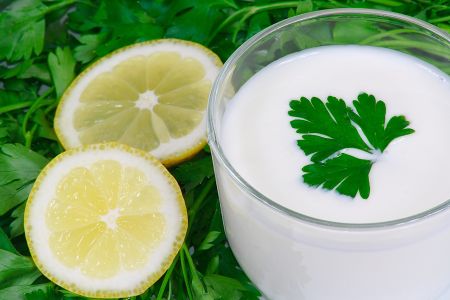

Kefir (pronounced ‘kuh-feer˙’) is a cultured/fermented dairy product that originated with shepherds of the North Caucasus region who discovered that fresh milk carried in leather pouches would occasionally ferment into an effervescent beverage. This is because the fresh raw milk was rich in probiotic bacteria and yeasts.
Nowadays, kefir is the result of mixing ‘kefir grains,’ composed of a complex structure of bacteria and yeasts with proteins, lipids, and sugars, with milk. The microorganisms ferment the naturally-occurring milk sugar, lactose, into a sour, slightly carbonated beverage with a consistency similar to thin yogurt.

What’s So Great About Kefir?
The taste of kefir is unmistakable: it has an ever so slightly malt flavor with an effervescent feel, not dissimilar to buttermilk. Authentic homemade kefir, or kefir made with traditional methods – which is not pasteurized post-production – will be teeming with healthy probiotic bacteria. Probiotic bacteria help to maintain the ideal ratio of ‘good’ bacteria to ‘bad’ bacteria in the intestines and, in turn, help to maintain the overall health of the digestive tract.
Kefir is also a great source of easily digestible dairy protein, carbohydrate, of course calcium, but also B vitamins including B12, potassium, phosphorus, and zinc. Because the probiotic bacteria ferment the lactose, kefir, like all ferment dairy products are naturally low in lactose and often can be enjoyed by those with lactose intolerance.
Kefir can be made at home, and various cooperatives and organizations offer kefir-making workshops. One such organization is the Weston A. Price Foundation, which also publishes instructions for dairy kefir, below. Note that cleanliness is of paramount importance, to minimize risk of spoilage and food poisoning.
The instructions here are for making kefir the traditional way, from kefir grains. Kefir can also be made from a powdered starter, but this is a more expensive approach, as you will need to use a fresh starter every 1-7 brews (depending on the quality of the starter). Kefir grains, on the other hand, can be reused indefinitely and they will continue to multiply, so you will eventually have enough kefir grains to start sharing them with others.
Ingredients:
1 Tbsp. kefir grains
1 cup raw milk (preferably)
You will also need:
2 glass jars (such as Mason jars), with metal lids, a plastic mesh strainer, and a rubber seal that will allow excess pressure to escape, to prevent risk of explosions; sterilized
A wooden or plastic spoon (do NOT use metal utensils with the kefir grains); clean
Place the kefir grains and raw milk into a glass jar. Let sit at room temperature out of direct sunlight for 24-48 hours (or until the grains have properly fermented the milk).
Strain the kefir into another jar using a plastic mesh strainer. You can now drink the kefir immediately or cover with a lid and place in the refrigerator to chill first.
The kefir grains that are in the strainer can then be put back into the empty jar (rinse the jar first, if needed). Add more fresh milk and repeat the process.
If you do not want to make another batch right away, store the grains with enough milk to cover them in the refrigerator. You can store them with the lid on, as they will not produce much gas when refrigerated. Replace the milk with fresh milk once a week.
Kefir can also be made vegan, as guided by Cultures for Health
Place the milk kefir grains in nut, seed, coconut, or organic soy milk, and stir with a clean non-metal spoon. Allow to culture in a well-sealed jar, for 12 to 24 hours. After the 12th hour, check the kefir every few hours; when the kefir reaches the desired consistency, remove the grains.
It’s important to note that kefir grains are live bacteria and yeasts, as opposed to the starter kits from health food stores, which are freeze-dried. The starter kits will give you one batch at a time, whereas the live grains can be used over and over again. Taking care of kefir grains is easy: simply “revitalize” them by placing them in dairy milk or water kefir (finished kefir, not the water kefir grains) so that they have “food” and are able to grow.
Kefir made at home would vary greatly in the concentration and type of bacteria and yeast, making it impossible to guarantee any therapeutic effect. Nevertheless, kefir is a highly nutritious product. There is some research to show that a good quality kefir, made with live grains, and those found in products made following strict quality assurance practices – which guarantee a minimum number of bacteria and yeast – can colonize the digestive tract enough to increase the amount of bacteria in the gut, helping to promote a healthy digestive tract for everyday maintenance. If you’re looking for therapeutic probiotic to prevent travelers’ diarrhea, or to reduce the risk for antibiotic associated diarrhea, then you’ll need to choose a clinically proven probiotic supplement or food. As part of a healthy diet, kefir can be a valuable addition, and can be easily incorporated.
Kefir is Not Yogurt
Kefir and yogurt are both fermented dairy products; therefore, this may lead some to assume that both kefir and yogurt offer the same health benefits. However, this is not the case, as kefir contains different types of beneficial bacteria that yogurt does not. Fresh kefir also contains significantly more bacteria than yogurt, and yogurt is produced primarily by the action of two specific bacteria: Lactobacillus bulgaricus and Streptococcus thermophilus. Once the milk has been fermented, the amount of live bacteria may be negligible, and often, food companies will heat pasteurize the yogurt afterwards to extend its shelf life. Many yogurts, particularly those that are not fortified with additional beneficial bacterial strains, have been shown to not have any beneficial probiotic effect beyond being an easily digestible dairy food.
What, or whom, is living in that clump of bacteria?
Typically kefir grains will contain the following, although there is some variation between batches:
- Lactococcous lactis lactis
- Lactococcous lactis cremoris
- Lactococcous lactis diacetylactis
- Leuconostoc mesenteroides cermoris
- Lactobacillus kefyr thermophilic
- Klyveromyces marxianus marxianus
- Saccaromyces unisporis
- Acetobacter species and Streptococcus species
- and more…..
How to Use Kefir
Kefir, whether it’s homemade using live kefir grains, or a good quality store-bought product, can be used almost anywhere you’d use milk – cereal, smoothies, as a beverage straight up in a glass, and in baking – and as a substitute for yogurt or sour cream.
Learn more about healthy foods (and the foods never to eat) by clicking here.
Comments 7
Leave a Reply
You must be logged in to post a comment.




I have been drinking a kefir smoothie for three years, made with skim milk, frozen berries, banana, local honey, true cinnamon, cocoa nibs and a teaspoon of coconut oil. I have never been healthier. In the winters, if I got a cold, I would never have to be in bed. Also, my allergies have been much better. I got my grains from a women that got her grains from her oncologist. I have shared my grains with many friends looking to get healthy.
Amazon carries kefir grains (http://www.amazon.com/s/ref=nb_sb_noss?url=search-alias%3Daps&field-keywords=kefir%20grains), as do some merchants on eBay (http://www.ebay.com/sch/i.html?_trksid=p2050601.m570.l1313.TR0.TRC0.H0.Xkefir+grains&_nkw=kefir+grains&_sacat=0&_from=R40).
where can you buy or get kefir grains????
Where can I get Kefir Grains?
@MLynnM – you can make kefir with any mammalian milk..I use goat milk at home with fresh kefir ‘grains’….
I’ve been told, too, by a nutritionist, that by the time the fermenting is done, there is negligible hormonal activity left in kefir. I am avoiding estrogen in foods as much as possible and the nutritionist said that goat kefir would be fine. Can we add goat kefir to the food list, please?
I’m from Latvia and I grove up on it it’s a part of a daily diet.